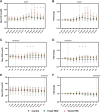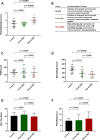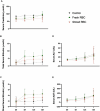Storage duration of packed red blood cells transfused during veno-venous extracorporeal membrane oxygenation is associated with elevated pulmonary artery pressure and lung injury in a sheep model
- PMID: 40514712
- PMCID: PMC12164121
- DOI: 10.1186/s13054-025-05438-z
Storage duration of packed red blood cells transfused during veno-venous extracorporeal membrane oxygenation is associated with elevated pulmonary artery pressure and lung injury in a sheep model
Abstract
Background: Veno-venous extracorporeal membrane oxygenation (VV-ECMO) is associated with a high transfusion burden. While trials have concluded that red blood cell (RBC) storage does not impact patient morbidity and mortality in the critically ill or cardiac surgical cohorts, evidence is sparse for ECMO cohorts. A sheep model was to investigate this question. On an underlying injury of smoke inhalation, we compared fresh (< 5 days) or stored (35-42 days) RBC transfusion with no transfusion. Clinically relevant outcomes included pulmonary artery pressure as well as biochemical or histopathological markers of lung, liver, and renal injury.
Methods: Twenty-four female Merino/Samm Border Leicester Cross sheep were anaesthetised and placed on pressure-controlled ventilation. They were instrumented for continuous haemodynamic monitoring. They then underwent smoke inhalation injury, followed two hours later by veno-venous ECMO. Sheep were randomised to three groups: control (no transfusion (n = 8)), fresh RBC (n = 8) and stored RBC (n = 8) transfusion occurring six hours after ECMO initiation. Blood samples were taken regularly, and 24 h post-ECMO, animals were sacrificed. Post-mortem samples of lung and kidney were collected for post-mortem analyses.
Results: Following ECMO initiation and transfusion, pulmonary artery pressure increased in the stored RBC group. Histopathological analysis also demonstrated a significantly elevated lung injury in this group. This lung injury was characterised by greater extravasation of inflammatory cells as well as bronchiole damage and oedema. Renal histopathology showed no significant differences between groups. Alanine aminotransferase, aspartate aminotransferase and bilirubin levels increased in a time dependent manner post-transfusion but there were no treatment-associated differences. During experimentation, the coagulation profile changed with firmer clots forming more quickly. Differences were observed between both transfusion groups and controls.
Conclusions: Transfusion of stored RBC elevated pulmonary artery pressure when compared to fresh RBC transfusion and controls. This change was correlated with a greater post-transfusion lung injury in the stored RBC group. Further investigation assessing whether insufficient nitric oxide had a role in these findings is warranted, as is consideration of longer ECMO durations and greater transfusion volumes.
Keywords: Extracorporeal membrane oxygenation; Lung injury; Pulmonary artery pressure; Red blood cell storage; Transfusion.
© 2025. The Author(s).
Conflict of interest statement
Declarations. Ethics approval and consent to participate: This study was approved by the animal research and ethics committees of the Queensland University of Technology and the University of Queensland (approval numbers 1100000053 and 1000000025 respectively). Work adhered to the Australian Code for the Care and Use of Animals for Scientific Purposes, Eighth Edition, 2013 of the National Health and Medical Research Council. Consent for publication: Not applicable. Competing interests: The authors declare no competing interests.
Figures




Similar articles
-
Anticoagulation and Transfusions Management in Veno-Venous Extracorporeal Membrane Oxygenation for Acute Respiratory Distress Syndrome: Assessment of Factors Associated With Transfusion Requirements and Mortality.J Intensive Care Med. 2019 Aug;34(8):630-639. doi: 10.1177/0885066617706339. Epub 2017 May 1. J Intensive Care Med. 2019. PMID: 28460592
-
Evidence of altered haemostasis in an ovine model of venovenous extracorporeal membrane oxygenation support.Crit Care. 2017 Jul 29;21(1):191. doi: 10.1186/s13054-017-1788-9. Crit Care. 2017. PMID: 28754139 Free PMC article.
-
Comparison of Coagulation Parameters, Anticoagulation, and Need for Transfusion in Patients on Interventional Lung Assist or Veno-Venous Extracorporeal Membrane Oxygenation.Artif Organs. 2015 Sep;39(9):765-73. doi: 10.1111/aor.12464. Epub 2015 Apr 29. Artif Organs. 2015. PMID: 25921195 Clinical Trial.
-
Red blood cell transfusion in veno-arterial extracorporeal membrane oxygenation - the disconnect between oxygen delivery and tissue oxygenation.Perfusion. 2025 Apr;40(1_suppl):15S-28S. doi: 10.1177/02676591241239569. Epub 2025 Apr 22. Perfusion. 2025. PMID: 40263905 Review.
-
Transfusion of red blood cells stored for shorter versus longer duration for all conditions.Cochrane Database Syst Rev. 2018 Dec 22;12(12):CD010801. doi: 10.1002/14651858.CD010801.pub3. Cochrane Database Syst Rev. 2018. PMID: 30578732 Free PMC article.
References
-
- Brogan TV, Thiagarajan RR, Rycus PT, Bartlett RH, Bratton SL. Extracorporeal membrane oxygenation in adults with severe respiratory failure: a multi-center database. Intens Care Med. 2009;35(12):2105–14. - PubMed
-
- Organization ELS. ECLS International Summary of Statistics 2023 [Available from: https://www.elso.org/registry/internationalsummaryandreports/internation...
-
- Munshi L, Walkey A, Goligher E, Pham T, Uleryk EM, Fan E. Venovenous extracorporeal membrane oxygenation for acute respiratory distress syndrome: a systematic review and meta-analysis. Lancet Respir Med. 2019;7(2):163–72. - PubMed
-
- Kim JH, Pieri M, Landoni G, Scandroglio AM, Calabrò MG, Fominskiy E, et al. Venovenous ECMO treatment, outcomes, and complications in adults according to large case series: a systematic review. Int J Artif Organs. 2021;44(7):481–8. - PubMed
MeSH terms
Grants and funding
LinkOut - more resources
Full Text Sources
Medical

